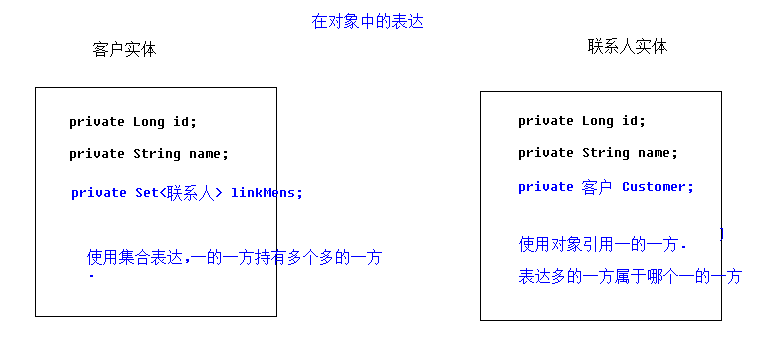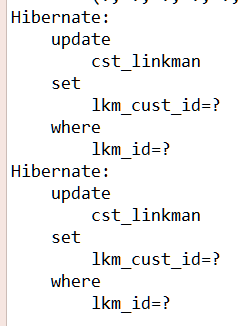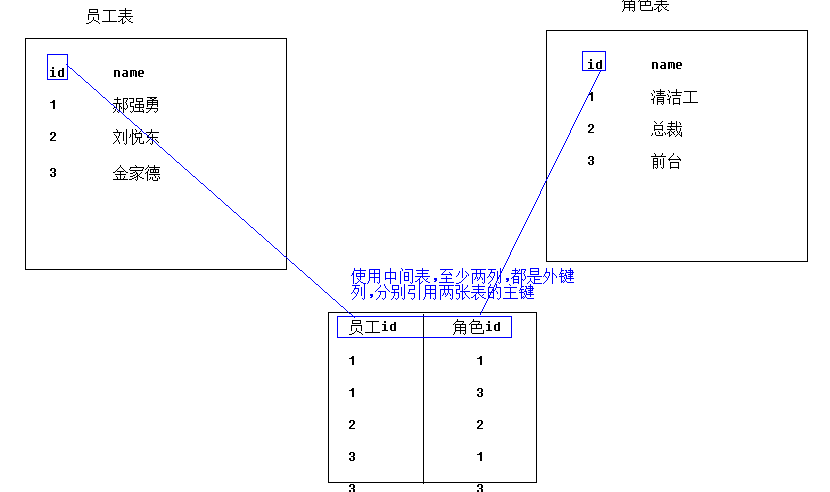One-to-many | many-to-one
1. Relational expression
Expressions in the Expressions

Entity expression

Expressions in orm metadata
One-to-many
<! - Sets, one-to-many relationships, configure in configuration files - >
<!--
Name attribute: collection attribute name
Column attribute: foreign key column name
Class attribute: the full class name of the object associated with me
-->
<set name="linkMens" inverse="true" cascade="delete" >
<key column="lkm_cust_id" ></key>
<one-to-many class="LinkMan" />
</set>
More to one
<! - Many to one-->
<!--
Name attribute: reference attribute name
Column attribute: foreign key column name
Class attribute: the full class name of the object associated with me
-->
<many-to-one name="customer" column="lkm_cust_id" class="Customer" >
</many-to-one>
2. Operation
Operational association properties
//3 operation Customer c = new Customer(); c.setCust_name("Wisdom Podcast"); LinkMan lm1 = new LinkMan(); lm1.setLkm_name("Dawn of Dawn"); LinkMan lm2 = new LinkMan(); lm2.setLkm_name("Liu Yuedong"); //Express one-to-many,There are multiple contacts under the customer c.getLinkMens().add(lm1); c.getLinkMens().add(lm2); //Express pairs,Which customer does the contact belong to? lm1.setCustomer(c); lm2.setCustomer(c); session.save(c); session.save(lm1); session.save(lm2);
3. Advanced operation
Cascade operation
<!--
Cascade operation: cascade
save-update: Cascading save updates
delete: Cascade deletion
all:save-update+delete
Cascade operation: Simplify operation. The purpose is to save two lines of code.
-->
<set name="linkMens" inverse="true" cascade="delete" >
<key column="lkm_cust_id" ></key>
<one-to-many class="LinkMan" />
</set>
Conclusion: Simplify the operation. Be sure to use save-update. It is not recommended to use delete.
Relation Maintenance

When saved, both sides will maintain the foreign key relationship. Relations are maintained twice, which is redundant. Redundant maintenance relations statements are obviously maintained by the client side.
The inverse attribute: Is the configuration relationship maintained?
true: customer does not maintain relationships
False (default): customer maintains relationships
inverse attribute: Performance optimization. Improve the performance of relationship maintenance.
Principle: No matter how you give up, there will always be one party who must maintain the relationship.
In a one-to-many relationship, one party gives up and only one party gives up.
-->
<set name="linkMens" inverse="true" cascade="delete" >
<key column="lkm_cust_id" ></key>
<one-to-many class="LinkMan" />
</set>
2. Many-to-many
1. Relational expression
Expressions in the Expressions

Object

orm metadata
<! - Mu lt i-to-Many Relation Expressions - >
<!--
Name: Collection property name
Table: Configure the middle table name
key
|- column: Foreign key, someone refers to the foreign key column name of "I"
Class: Which class do I have a many-to-many relationship with?
Column: Foreign key. I refer to the foreign key column name of Biren.
-->
<! - Cascade cascade operation:
save-update: Cascading save updates
delete: Cascade deletion
all: Cascade save update + Cascade delete
Conclusion: cascade simplifies code writing. This attribute makes it indifferent not to use it. It is recommended that only save-update be used.
If delete operation is too dangerous, especially in many-to-many. It is not recommended.
-->
<set name="roles" table="sys_user_role" cascade="save-update" >
<key column="user_id" ></key>
<many-to-many class="Role" column="role_id" ></many-to-many>
</set>
2. Operation
Operational association properties
//3> User Expressive Relations u1.getRoles().add(r1); u1.getRoles().add(r2); u2.getRoles().add(r1); u2.getRoles().add(r2); //4> Role Expressive Relations r1.getUsers().add(u1); r1.getUsers().add(u2); r2.getUsers().add(u1); r2.getUsers().add(u2); //5> call Save Method One-time Preservation session.save(u1); session.save(u2); session.save(r1); session.save(r2);
3. Operation Advancement
inverse attribute
<! -- Use the inverse attribute
true: Abandoning Maintaining Foreign Key Relations
False (default): Maintaining relationships
Conclusion: In the future, if we encounter many-to-many relationship, we must choose one side to abandon the maintenance relationship.
Generally, who gives up depends on the direction of the business. For example, when entering an employee, it is necessary to assign the role to which the employee belongs.
Then the business direction is to maintain roles by employees. Roles do not need to maintain relationships with employees. Roles abandon maintenance.
-->
<set name="users" table="sys_user_role" inverse="true" >
<key column="role_id" ></key>
<many-to-many class="User" column="user_id" ></many-to-many>
</set>
Cascading attributes
<! - Cascade cascade operation:
save-update: Cascading save updates
delete: Cascade deletion
all: Cascade save update + Cascade delete
Conclusion: cascade simplifies code writing. This attribute makes it indifferent not to use it. It is recommended that only save-update be used.
If delete operation is too dangerous, especially in many-to-many. It is not recommended.
-->
<set name="roles" table="sys_user_role" cascade="save-update" >
<key column="user_id" ></key>
<many-to-many class="Role" column="role_id" ></many-to-many>
</set>
3. Exercise: Adding Contacts

servlet:
protected void doGet(HttpServletRequest request, HttpServletResponse response) throws ServletException, IOException { //1> Obtain parameters and package them LinkMan Object LinkMan lm = new LinkMan(); try { BeanUtils.populate(lm, request.getParameterMap()); } catch (IllegalAccessException e) { e.printStackTrace(); } catch (InvocationTargetException e) { e.printStackTrace(); } //2> call Service Preservation LinkMan object lms .save(lm); //3> Redirect to LinkMan List of(404) response.sendRedirect(request.getContextPath()+"/ListLinkManServlet"); }
service:
private CustomerDao cd =new CustomerDaoImpl(); private LinkManDao lmd = new LinkManDaoImpl(); public void save(LinkMan lm) { //Open a transaction HibernateUtils.getCurrentSession().beginTransaction(); try { //1 According to customers id Get the customer object Long cust_id = lm.getCust_id(); Customer c = cd.getById(cust_id); //2 Put customers in LinkMan Intermediate Expressive Relations lm.setCustomer(c); //3 Preservation LinkMan lmd.save(lm); } catch (Exception e) { e.printStackTrace(); //Roll back transactions HibernateUtils.getCurrentSession().getTransaction().rollback(); } //Submission transaction HibernateUtils.getCurrentSession().getTransaction().commit(); }
dao:
public void save(LinkMan lm) { //1 Get session Session session = HibernateUtils.getCurrentSession(); session.save(lm); }